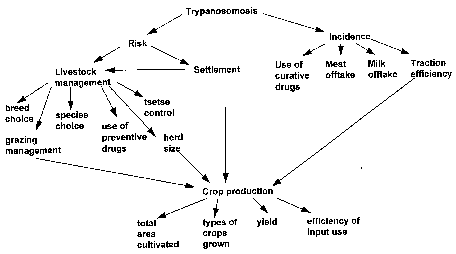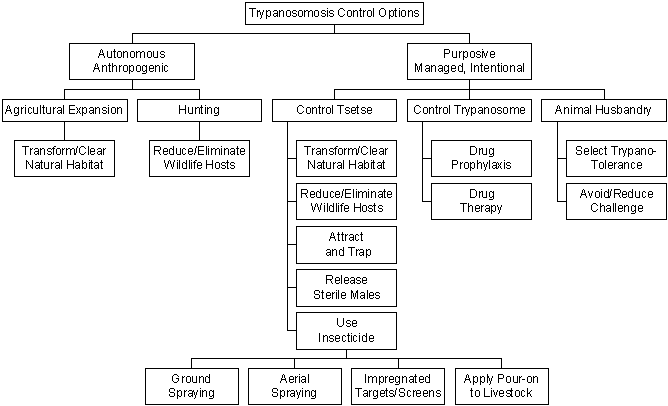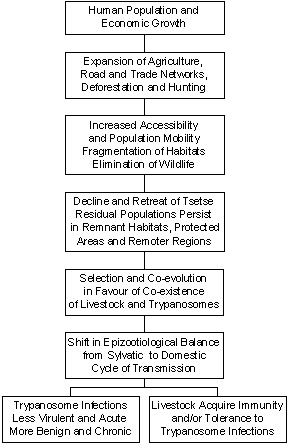Environmental Research Group Oxford Limited |
|||||||||||||||||||||||||||||||||||||||||||
|
UK Department for International Development’s Animal Health Programme |
|||||||||||||||||||||||||||||||||||||||||||
|
Environmental Change and the Autonomous Control of Tsetse and Trypanosomosis in Sub- Saharan Africa Case histories from Ethiopia, The Gambia, Kenya, Nigeria and Zimbabwe |
|||||||||||||||||||||||||||||||||||||||||||
|
David Bourn, Robin Reid, David Rogers, Bill Snow and William Wint |
|||||||||||||||||||||||||||||||||||||||||||
|
Given the prevalence of autonomous, anthropogenic control of trypanosomosis, a pre-requisite for the sustainability of any additional form of control, at individual or community level, is that potential beneficiaries perceive the disease to be a genuine problem and priority concern, compared with other livelihood or community constraints. | |
|
Formulation of sensible national poverty reduction and sustainable disease control strategies requires reliable information about the agricultural economy, faming systems, the evolving role of livestock and the relative importance of animal diseases. | |
|
It is the collective responsibility of national Ministries of Agriculture, Veterinary Departments and Statistical Offices to arrange for the regular collection, validation, dissemination and updating of such information, which is most conveniently stored, examined and manipulated in computer-based Geographical Information Systems. | |
|
At the international level, agencies such as the Food and Agriculture Organisation of the United Nations and the Inter-African Bureau for Animal Resources should provide guidance, oversight and technical assistance. | |
|
Donors should support such initiatives under the rubric of promoting good governance and sustainable development, which require reliable information to establish priorities, target interventions and monitor impacts. |
Introduction
A Long and Winding Road
Colonial authorities were much concerned with the control of trypanosomosis that was widely perceived to be a continental constraint on human health, livestock production and agricultural development in tropical Africa. Attention focused, initially, on field investigations and containing widespread epidemics of human sleeping sickness. Major surveillance and treatment campaigns were mounted across Africa, and international conferences on the subject were held in London in 1907 and Paris in 1928. Subsequently, after the Second World War and the advent of cheap and effective insecticides, attention turned more towards veterinary aspects and the control of tsetse and animal trypanosomosis for the potential supply of animal protein to Europe. A third international conference, held in Brazzaville in 1948, recommended the formation of an International Scientific Committee for Trypanosomiasis Research to co-ordinate further studies. The committee was duly established by the Commission for Technical Co-operation South of the Sahara and held its first conference in London in February 1949. UK government support for that organisation has been maintained since then, and the fiftieth anniversary of the committee’s foundation was marked by the twenty-fifth conference held in Mombasa in 1999, under the auspices of the Scientific, Technical and Research Commission of the Organisation for African Unity.
Box 1: “Zoonotic” Disease of Wildlife, Livestock and People
|
Tsetse-borne trypanosomosis is a widespread, protozoal disease-complex affecting wildlife, livestock and people in sub-Saharan Africa, with a range of pathologies, from chronic and long lasting to acute and rapidly fatal, depending on circumstances. Wildlife, including: warthog, bush pig, duikers, bush buck, kudu, buffalo and monitor lizards are the natural hosts of tsetse and may acquire prolonged, symptomless infections. Livestock exhibit a range of susceptibilities to infection, from refractory to highly vulnerable. Some livestock breeds are recognised as being trypanotolerant. Spontaneous self-cure and recovery may occur and partial immunity may be acquired. Two forms of human sleeping sickness are recognised: the Gambian type, found in western and central Africa, which is a chronic and mild infection that can last for years, although individuals can recover spontaneously; and the Rhodesian type, in eastern and southern Africa, which causes acute illness lasting several weeks and is usually fatal without treatment. |
It has been conservatively estimated that UK contributions to tsetse and trypanosomosis research and control since 1980 have amounted to at least £35.6 million (US$53.4 million at US$1.5/£stg) (Budd, 1999). An independent scientific review of studies undertaken during that period (Melitz et al., 1998) acknowledged significant scientific achievements and greatly improved understanding, but questioned how this knowledge was to be applied at farmer level. Much of the motivation for tsetse and trypanosomosis research and control in post-independent Africa has been donor-driven and, until relatively recently, the approach adopted for vector control has been centrally managed and decidedly “top-down”, with minimal community involvement in the planning and implementation process. The sustainability of such initiatives has been called into question (Barrett and Okali, 1999) and is likely to remain elusive, unless and until livestock farmers and/or local communities perceive vector control to be a priority and demonstrate a genuine demand for such measures.
Veterinary services across Africa have been widely criticised for focusing on the wrong priorities, undertaking the wrong tasks and lacking effective management. General principles for the rational delivery of public and private veterinary services, with particular reference to Africa, have been prepared but the pace of reform has been slow and erratic. Current trends are for the continued promotion of institutional reform, decentralisation, privatisation, cost-recovery and wider use of animal health assistants. Future donor support to animal health and livestock production services is likely to be closely linked to institutional reform and improved service delivery to small-scale producers.
Box 2: Contributions of Livestock to the Livelihoods of the Rural Poor
|
Livestock are, or can be:
Source: LID (1998) |
|||||||||||||||
Figure 1: Impacts of Trypanosomosis on Farming and Livelihoods

(Source: Swallow, 1997)
Smallholder Livestock Production Systems
Fundamental differences exist in the structure, objectives and function between smallholder farms and large-scale commercial enterprises, including: the multi-functionality of livestock in small-holder systems (Box 1); the integrated nature of livestock activities; the multiple objectives of producers; and their restricted capacity to bear risk; as well as generally poor infrastructure and limited access to markets and information at community level (McDermott et al., 1999). The distinguishing features of specific smallholder livestock production systems must be taken into account in assessing existing disease control strategies and evaluating opportunities for improvement. The potential impacts of the risks and incidence of trypanosomosis on farming and livelihoods in Africa are summarised in Figure 1.
The direct impacts of trypanosomosis incidence are the morbidity, mortality, lower work efficiency and the costs of treatment for animals that contract the disease. The direct impacts of trypanosomosis risk are the livestock management practices that farmers follow because of the risk to which their animals are, or could be, exposed. The indirect impacts of trypanosomosis incidence are the changes in human settlement, crop production and land use that occur due to the reduced productivity of existing animals. The indirect impacts of trypanosomosis risk include the changes in human settlement and crop production that occur because of the livestock management practices followed by farmers who raise livestock under trypanosomosis risk (Swallow, 1997).
Figure 2: Processes of Environmental Change and Autonomous Control of Trypanosomosis
Environmental
Change and the Autonomous Control of Trypanosomosis
Human population growth, agricultural expansion and economic development have wrought profound changes in vegetation and land use in sub-Saharan Africa (Bourn et al., 2001). Annual rates of agricultural expansion at eighteen trypanosomiasis-affected study sites in Kenya, Ethiopia, Gambia Nigeria and Zimbabwe over the last four decades of the twentieth century ranged from -2.9% to +10.0%, with modal values of +2.5% to +5.0%. Prolonged and extensive hunting with increasingly sophisticated weaponry has eliminated game species from many areas where they were once common. With the widespread decline and disappearance of natural habitats and hosts, tsetse have retreated from large parts of their former range, and the wildlife reservoir of trypanosomosis has been greatly diminished.
With continued demographic pressure and ever widening human impacts on the environment, the further retreat of tsetse and reduction in the wildlife reservoir can be anticipated. The net effect has been a progressive realignment of the epizootiological balance of disease transmission away from its former wildlife orientation, towards one increasingly dominated by livestock and, to a lesser extent, man. Under such circumstances, natural selection in favour of adaptation and mutual co-existence of trypanosomes and domestic hosts is prevailing, and the disease is tending towards a more chronic and survivable form (Figure 1). It is within this context of environmental change and the autonomous, anthropogenic control of trypanosomosis, that the utility of more purposive disease control strategies and measures should be considered.
Nevertheless, wherever the vector persists in increasingly fragmented and discontinuous habitat, the risk of disease transmission will remain a constraint on livestock production and a threat to human health, for the foreseeable future, albeit at reduced and more manageable levels than before. Residual tsetse populations and trypanosomosis foci will survive in remnant patches of natural habitat, protected areas and remoter, inaccessible regions. How significant trypanosomosis will be, compared with other disease and production constraints, obviously depends on specific local circumstances and needs to be investigated thoroughly at local producer level before contemplating any form of intervention.
Disease Control Options
Options available for controlling animal trypanosomosis in Africa are identified in Figure 3. Autonomous, anthropogenic impacts that influence and modify the extent and severity of the disease (=control) are distinguished from more purposive, managed and intentional control measures. Autonomous control includes the environmental impacts of human population growth, the expansion of agriculture, settlements and road networks, and the elimination of wildlife, through hunting and habitat loss. Purposive control measures fall into three categories: those related to animal husbandry and breeding; those directed against the trypanosome; and those targeted at tsetse.
Figure 3: Factors Involved and Options Available for the Control of Trypanosomosis

Conclusions
Trypanosomosis is a widespread constraint on livestock production, mixed farming and human health in tropical Africa. However, the relative importance of different livestock diseases, as perceived by livestock producers, as opposed to veterinarians and livestock economists, is not well documented. Even less is known about the relative importance of animal diseases, compared with other risks and demands of maintaining rural livelihoods and alleviating poverty.
Disease control initiatives are unlikely to achieve sustainable impacts, without the full support of local communities and the endorsement of national Governments. For such initiatives to have any chance of success in controlling disease and alleviating poverty, the disease itself must be recognised as a significant production constraint or human health problem and its control must be a priority concern of affected communities and Government (Box 3).
Box 3: Enabling Conditions for Poverty-Focused Animal Disease Control
|
Achieving sustainable, poverty-focused, animal disease control will depend on many factors, including: Farmer/Community Level
Government/Donor Level
|
From an international perspective, there has been poor co-ordination of disease and vector control measures, and a lack of integration with agricultural development. Economic and social impacts of trypanosomiasis have been poorly quantified, and liaison between governments, donors, research institutes and international organizations has been weak.
From a national perspective, trypanosomosis is just one of many diseases and other constraints affecting livestock and people in rural areas, and its importance must be judged against other pressing demands on limited budgets, including: CBPP, foot and mouth, Newcastle disease, rinderpest and tuberculosis, as well as the much more devastating impacts of HIV/AIDS and malaria. In these circumstances, it is not surprising that veterinary departments are compelled to focus on more acute diseases than devote limited resources to the control of chronic endemic diseases, such as trypanosomosis, which is being controlled autonomously by agricultural expansion.
From a livelihoods perspective, trypanosomosis may or may not be important, depending on whether it is a human or animal health risk; the relative importance of livestock production and animal husbandry; what species and breeds of livestock are kept; and their susceptibility to local strains of the disease. Clearly, the relative importance for trypanosomosis will differ according to circumstance, from livelihood to livelihood, and system to system.
For strategic planning and monitoring purposes, however, there is a urgent need for reliable, and reasonably up to date information about the distribution and abundance of people, agriculture and livestock, and the incidence and relative economic importance of different diseases. It is the collective responsibility of national Ministries of Agriculture, Veterinary Departments and Statistical Offices to arrange for the regular collection, validation, dissemination and updating of such information, which is most conveniently stored, examined and manipulated in computer-based Geographical Information Systems (GIS). The international community should provide guidance, oversight and technical assistance, through such organisations as the Food and Agriculture Organisation of the United Nations and the Inter-African Bureau for Animal Resources. Donors should support such initiatives under the rubric of promoting good governance and sustainable development, which require reliable information to establish priorities, target interventions and monitor impacts.
References
Barrett, K. and C. Okali (1999).
"Partnerships for tsetse control". Twenty-fourth Meeting of the International
Scientific Council for Trypanosomiasis Research and Control, Maputo, Mozambique, 29
September - 4 October 1997, Nairobi: Organisation of African Unity and International
Scientific Council for Trypanosomiasis Research and Control.
Bourn, D. M., R. S. Reid, D. J.
Rogers, W. F. Snow and G. R. W. Wint, Eds. (2001). Environmental change and the
autonomous control of tsetse and trypanosomosis in sub-Saharan Africa: case histories from Ethiopia,
Gambia, Kenya, Nigeria and Zimbabwe. Oxford: Environmental Research Group Oxford
Limited.
Budd, L. (1999). "Volume 2:
economic analysis". In: DFID-funded
tsetse and trypanosome research and development since 1980. Chatham: Department for
International Development: Livestock Production, Animal Health and Natural Resources
Systems Programmes.
LID (1998). "The integration of
livestock interventions into a sustainable rural livelihoods approach".
In: D. Carney, Sustainable rural livelihoods -
what contribution can we make? London: Department for International Development.
McDermott, J. J., T. F. Randolph and
S. J. Staal (1999). “The economics of optimal health and productivity in smallholder
systems in developing countries.” Rev. sci. tech. Off. Int. Epiz. 18(2):
399-224.
Mehlitz, D., S. Geerts and U.
Feldmann (1998). "Volume 1: scientific review". In: DFID-funded tsetse and
trypanosome research and development since 1980. Chatham: Department for International
Development: Livestock Production, Animal Health and Natural Resources Systems Programmes.
Swallow, B. M. (1997). "Impacts of trypanosomosis on African agriculture". Twenty-fourth Meeting of the International Scientific Council for Trypanosomiasis Research and Control, Maputo, Mozambique, 29 September - 4 October 1997, Nairobi: Organisation of African Unity and International Scientific Council for Trypanosomiasis Research and Control.

